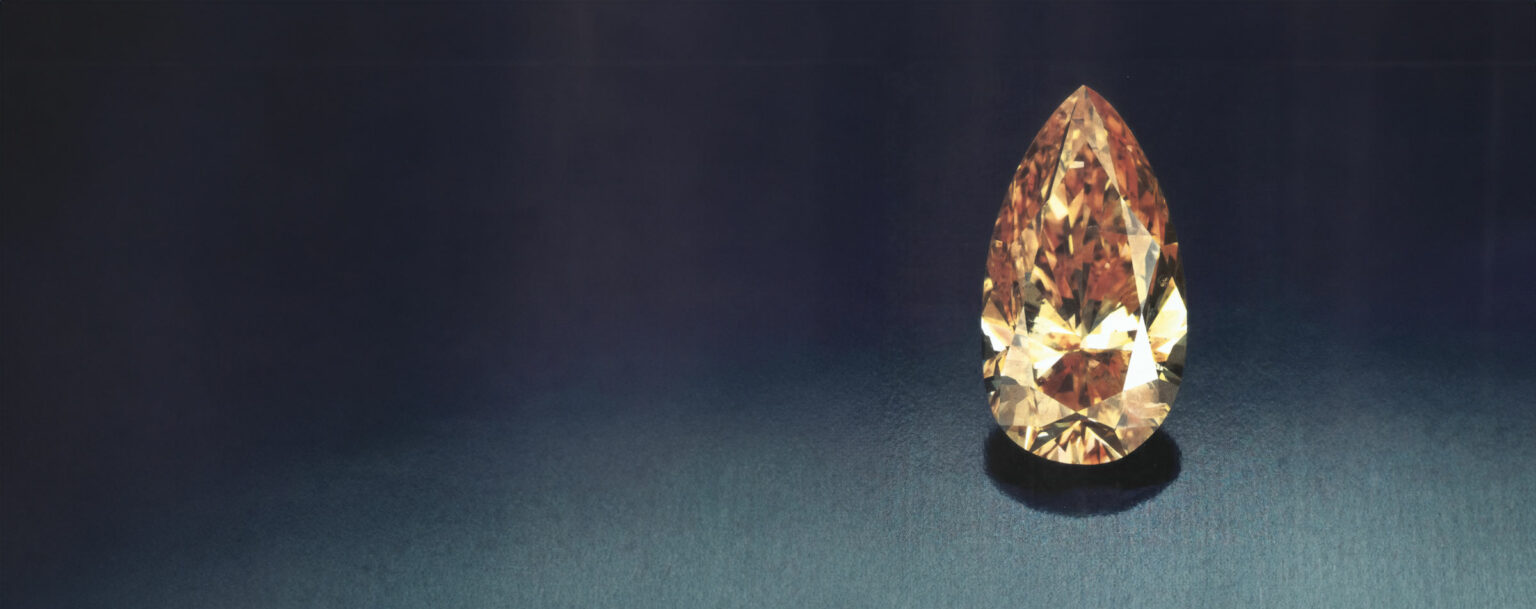Creation plays by very frustrating rules when it comes to pure red and orange diamonds. Yet with nearly 100 million carats of diamond mined annually, collectors of fancy colors still feel good reason to hope for a handful of stones with these two rarest of shades. So while the search for pure orange diamonds is like looking for a needle in a haystack, it is child’s play next to the grail-quest for pure red diamonds.
Nature is sporting enough to provide encouraging numbers of fancy close diamonds with golden amber and fiery autumn hues, but the orange in these stones usually amounts to a secondary tinge or color highlight. Collectors lucky enough to own the occasional orange stone whose hue is truly conjures pumpkin or cantaloupe know they possess one of the world’s rarest diamond treasures. There are just enough of these stones to nourish dreams of owning one. But reality nearly always falls far short of fantasy. “I’ve seen a dozen diamonds that were certified as pure orange,” says fancy color diamond specialist Alan Bronstein, Aurora Gems, New York. “Unfortunately, only three faced up with decent color. The others were too washed out.”
So close and yet so far.
To bolster orange in diamonds, nature endows most with brown. This blending is variously described as “burnt orange,” “cognac” and “copper” in the trade.
The lopsided ratio between pure-orange and brown-orange diamonds widens in the laboratory where since the late 1940s treaters have been roasting diamonds to sizzling shades of fancy intense yellow and burnt orange via a two-step process of high-energy irradiation followed by high-temperature heat. Yet after more than 40 years, diamond-colorizing adepts still haven’t found a way to regularly induce pure orange pigments. Producing subtle colors reminiscent of cantaloupe remains as elusive as ever.
Hence rarity second only to that of true-red diamonds makes the 2.10-carat pure-orange stone shown on the opposite page a bona fide pinnacle of the diamond beauty. This stone, among the many standouts of the 250-specimen Aurora colored diamond collection on display at New York’s American Museum of Natural History, is one of two we have seen. The Gemological Institute of America’s (GIA) Gem Trade Lab paid this stone the highest praise possible for its hue by grading it “fancy orange.” GIA rarely allows a diamond to leave its lab with this designation. Here’s why.
Into the Green
There are many orangey but almost no orange diamonds in the marketplace. Pure orange, it seems, is a lot, maybe too much, to ask of the color chemistry and mechanics that govern diamonds. “Never forget,” urges gemologist Stephen Hofer, Colored Diamond Laboratory Services, Miami, “that orange is a hybrid, in the truest sense, between yellow and red. So it’s par for the course to see strong modifiers in orange diamonds.”
To understand why orange in diamonds is usually a mixture of hues, you must understand the causes of color in this gem. The diamond’s crystal lattice, composed of tightly bonded carbon atoms, makes this gem ultra-resistant to infiltration by impurity atoms. Nevertheless, atoms of two kinds often penetrate in sufficient quantities to act as coloring agents: nitrogen, the primary cause of yellow and orange, as well as boron, the primary cause of blue. But for every diamond blued by boron, a million are yellowed by nitrogen. Bluing and yellowing are usually slight rather than strong—so slight that color is generally masked by the diamond’s bleaching brilliance. However, a certain percentage of stones still qualify as colored diamonds.
Color in most yellow and orange diamonds is the result of a disturbance in a stone’s light-transmission ability. A nitrogen-free diamond transmits all visible spectrum colors at once in a perfectly blended form the eye perceives as “white light.” But mix in enough nitrogen and light transmission goes haywire as blue is absorbed and its complementary color, yellow, begins to dominate.
If a big if, the nitrogen affects transmission in blue’s neighboring spectrum region of green, its complementary color of orange becomes increasingly visible. Alas, absorption of green is almost always more mild than it is for blue. Hofer explains that nitrogen atoms are configured somewhat differently in orange diamonds than in yellow ones. The common yellow, or Cape series, diamond is colored by impurity atoms arranged in groups. However, when the same groups of nitrogen atoms are subjected to natural irradiation and heating, absorption is affected in the blue/green region of the spectrum—thereby causing orange body color. Far rarer dominant-orange stones are known as Type IIb diamonds and are believed colored by large concentrations of single nitrogen atoms. Orange rarely overpowers yellow, but rather competes with it.
Word Games
In most cases where orange in diamonds overwhelms yellow, it is usually accompanied by brown. The more brown modifies orange, the more it darkens tone and dominates the hue until ultimately stones must be classified as brownish rather than orange. Even when brown is a secondary color, some dealers fret when labs note any more than its minimal presence in an orange stone.
The commotion becomes crisis when brown intrudes to the point where it is the primary color. GIA and labs that copy its grading system for colored diamonds rate such stones “orange-brown” (when orange accounts for 25% to 50% of the color) or “orangy-brown” (when orange accounts for 25% or less of the color). Dealers who sell more on the basis of grading reports than the actual visual beauty of stones view these color grades as value-slashings setbacks. Hence the crisis of receiving such grades is ameliorated only when a lab overlooks or downplays the presence of brown. The trouble with such thinking is that it ignores the facts of life for most orange diamonds. Orange and brown are more apt to be paired in nature than orange and yellow.
Given this reality, the trade should re-evaluate hardened attitudes toward brown-orange diamonds. Argyle Diamond Mines in Australia, 50% of whose diamonds are brown, is spearheading new thinking in this area by calling its orangish-brown to brownish-orange stones “cognac” diamonds. Not only are these diamonds as beautiful as any, they represent, at prices often between $1,500 and $10,000 per carat in 1- to 2-carat sizes, some of the best remaining values in the diamond world. But don’t confuse cognac and burnt-orange colors with pure-orange ones. Lighter and sweeter, stones with the latter hues could contest off thousands of dollars per carat if they possess fine face-up color. This has as much to do with rarity as beauty.
Please note: this profile was originally published in 1992 in Modern Jeweler’s ‘Gem Profiles/2: The Second 60’, written by David Federman with photographs by Tino Hammid.
The 2.10-carat orange diamond in the header image is courtesy of Aurora Gems, New York.






